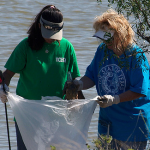What Are ‘Environmental Flows’ And How Does Texas Protect Them?
Even if the Lower Colorado River Authority (LCRA) doesn’t send water downstream to rice farmers this year, the Colorado River will still flow. Without that constant flow, the river would dry up, destroying and inland ecosystems and the brackish estuary near the coast.
But how much water should be sent downriver to maintain the ecosystem? That’s the job of the rarely-mentioned Environmental Flows Advisory Group, which met yesterday at the Capitol to hear testimony from the representatives of science advisory groups and business and residential interests.
Most of the testimony heard involved talk of the perpetual lack of funds for the labor intensive studies of how much water a river needs.
“We have an obligation through federal mandate to make sure that we are taking care of the environmental needs of the bays and estuaries,” says Rep. Troy Fraser, R-Horseshoe Bay, Co-Presiding Officer of the group. “It’s a balancing act, making sure that we are also supplying water to the people upstream.”
Fraser recently made headlines when he and Sen. Kirk Watson, D-Austin urged the LCRA not to release water from the Highland Lakes to downstream rice farmers this year in order to protect firm water supplies for the City of Austin and other municipal users.
When Texas passed an environmental flows law in 2007, the state was divided into eleven major “river basin” regions, shaped by the rivers’ watersheds and the bays and estuaries those rivers empty into. The eleven basins have a dizzying array of advisory groups, subcommittees, and stakeholder groups involved. These include the Bay/Basin Expert Science Team (BBEST), Science Advisory Committee (SAC), Environmental Flow Advisory Group (EFAG), and more.
The Environmental Flows Advisory Group includes members of the Texas Senate and House, as well as members of the Texas Commission on Environmental Quality, and the Texas Water Development Board, among other state agencies.
To figure out how much water Texas’ rivers need, scientists first assess a particular basin and bay’s water needs. Those needs are then parsed by business and residential interests along the river. The two sides then try to come to an agreement on how much water will be left to the fish, mussels, river plants, birds, and all other walks of life that rely on Texas’ freshwater flows. Finally, the Texas Commission on Environmental Quality makes rules on water flow amounts based on those findings.
Easier said than done.
The scientific assessments alone can take ten years, and almost every basin group at the meeting this week asked for more funding.
Patrick Brzozowski, speaking on behalf of scientists examining the Colorado and Lavaca Rivers, said his team would need more money to improve its scientific assessments.
“The most probable cost figure for the development of this information has been suggested as being between 2 and 4 million dollars,” Brzozowki said.
A decade is a long time to maintain political support and funding of scientific research in Texas.
Glenda Callaway, speaking on behalf of the Trinity, San Jacinto and Galveston areas, said it’s extremely difficult to embark on long-range water infrastructure development and protection if you can’t make budget projections beyond two years.
And two-year budget cycles and decade-long scientific studies are just scratching the surface.
“Our challenge is looking much further out, as far as 50 years out. How can we make sure that we are gong to have enough water for the people in this area 10, 20, 30, 40, 50 years out,” Rep. Fraser says. “And unfortunately, we don’t know what the weather patterns are going to be.”


